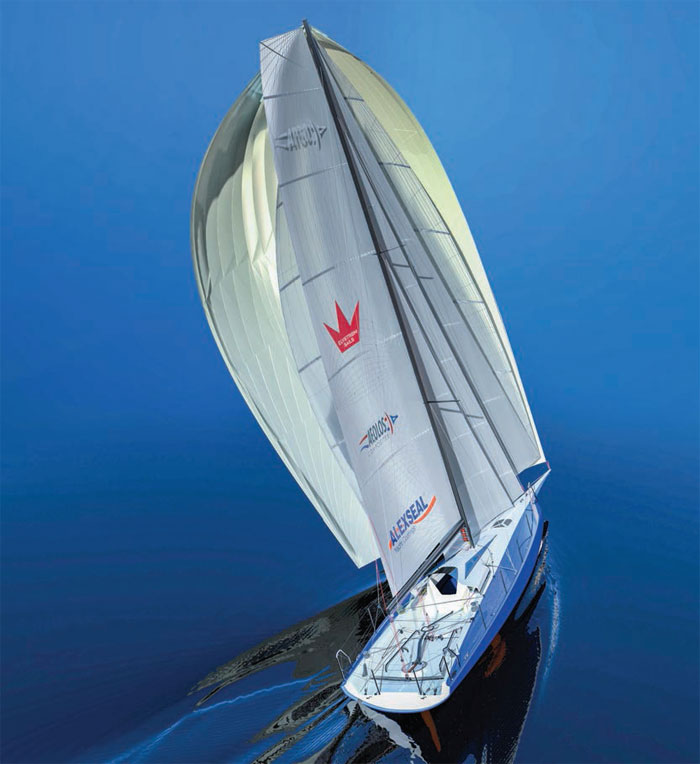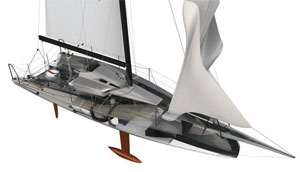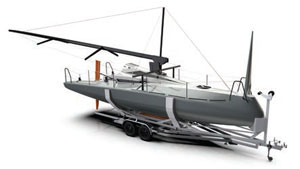

Two-time winner of the Silverrudder Hans Genthe explains his radical new doublehanded raceboat concept
Aeolos Yachts is addicted to scientific approaches. The base for our yacht design is market research and competitor analysis to understand the customer benefits. Aeolos does not design boats which suit everyone. We build boats which are perfect for a certain target group and which can be produced economically.’
The Aeolos P30 design
Hundreds of hours of optimisation result in a highly optimised shape. Our team tested various modifications of the hull with more rocker and/or more volume in the mid section with different fins and rudders. For all variations we checked the influence on the rating.
- Simple, reliable, light
- Full carbon prepreg (hull, keel, rudder, mast, bowsprit)
- Quick to assemble (without a crane), easy to transport
- Single/doublehanded (OSR2) and inshore racing with six crew
- CE-Norm Category B (offshore), upgrade to Cat A is possible with additional equipment
- Length: 9.14m
- Beam: 2.91m
- Displacement: 1.55t empty but rigged boat without sails and motor
- Sailing displacement: 1.98t doublehanded, fully equipped for three days’ sailing with 160kg crew
- Ballast ratio: more than 50 per cent (800kg)
- Draught: 2.3m to 0.5m
The most difficult issue in good boat design is three-dimensional thinking with heeling and waves. The Aeolos P30 is designed for shorthanded sailing with a crew of two, and for medium-range offshore use (up to 500 miles or two to three days) with a windspeed of 12-14kts (typical Baltic Sea and Solent conditions). The boat also works well around the cans with a crew of five to six.
The trim target is to sail the boat at the design heel angle of 25-30°. At this angle the keel bulb generates an enormous righting moment so you can carry big, powerful sails that produce a lot of forward driving power for much longer than usual.
The major innovation is the flat stern section. When heeled, the exit angle of the stern lines is almost zero, which gives a perfect planing shape. This boat moves through the waves quite smoothly when heeled – the bow section always has the same shape between 0-30° of heel.
One, two or three rudders?
The CFD calculations proved that a single rudder and a close eye on wetted surface is the best for short and medium distance racing in typical wind conditions. The double rudder version is recommended for long distance offshore racing at an average wind speed above 20kts upwind/16kts downwind (with kickup for UFOs: underwater floating objects). The rudder design is inspired by the flippers of humpback whales, which rely on its superior manoeuvrability when catching prey. A foil with tubercles offers safety in high waves because it improves the tolerance for the autopilot, meaning you can carry the big kite for longer. If you are unsure of your intended use, you can choose both systems and switch from single rudder to double rudder and back in a matter of minutes.
In light winds the Aeolos P30’s hull form has little wetted area and a very slender waterline. The circular shape in the front section offers maximum volume with minimum surface area when sailing upright. To improve its light wind performance, the P30 can be easily trimmed with crew weight on the bow to reduce its wetted area still further.
The cockpit layout is optimised for three downwind and upwind crew positions for light, medium and heavy wind. Downwind with light wind the crew stands beside the mast and trims the gennaker directly without winch. The helmsman sits to leeward, steering with the telescopic tiller extension. In heavy winds the crew uses the backstay winch behind the helmsman. The backstay is only necessary for trimming. Downwind the backstay can be left cleated.
Wind resistance increases at the square of speed
Due to the low, round sheerline, the P30’s aerodynamic coachroof has a considerably lower wind resistance than many yachts in this segment. Especially when heeling, the air flow to the jib has less turbulence. That means the jib is much more effective as it has more usable profile/area – and this without rating penalty. If you have to move to the bow in windy conditions you will love this shape, the deck offers an almost horizontal gangway when the boat heels.
The wide transom gives crew weight maximum effect and there’s a great view forward from the helm. In doublehanded mode you sleep in the carbon pipe cot below, with nearly the same righting moment as if sitting on deck with legs outside. The bunks are mounted relatively high at the boat’s widest point.
Protect yourself
A flat deck looks nice and has low wind resistance. But these boats are very, very fast, which means a lot of spray. After two nights in the spray without shelter, you will change your mind about a deckhouse. The P30’s deckhouse will adequately shelter the cockpit and the crew. Its wings hide the clutch bank for the halyards, which are set up so you can hoist the kite from the cabin entrance.
Rating or handling optimisation?
The ORC survey calculates quite accurately - that's why we see more potential to win a race by improving the handling of a boat than to optimise the rating to the last one. The Aeolos P30 allows easy, effortsaving sail changes and continuous trimming, while enabling dry sail changes at sea and peaceful sleep.

Above: the gennaker take down system is similar to those used to great effect by the TP52 fleet. When the kite is dry the crew just haul it in by hand, but when itʼs damp and heavy a high speed winch with four gears gives extra grunt.
Below: the P30 is designed to be eminently trailable as well as easily launchable without a crane, which should save a lot of expense when itʼs time to move the boats around

Sails
The large A2 gennaker stays attached in a gennaker sock and is set through the forehatch. The spinnaker retrieval system is one of the most powerful tools on board. A similar system driven by a grinder works well on much bigger TP52s. It is a unique combination of a smooth foredeck hatch, two ball bearing rollers below deck to compress the sail, a Teflon coated gennaker sock and a four-gear high speed Karver winch on the retrieval line. Normally it is possible to pull the gennaker in without needing the winch, but if the gennaker is wet, the Karver winch is a big help. In first gear the winch pulls approximately 65cm with each turn (standard winches pull 15cm). Changing gear is easily done with a rotation change. A water trap below the hatch catches spray, ensuring that when water is shipped it flows out easily.
In harbour the jib, cutter jib and trysail are stowed below the front bunk and at sea they’re kept above the front bunk. The code zero and flying jib are stored in the cockpit below the hatch, while the small gennaker hangs in a bag in the companionway, partly sheeted, and has a second set of sheets, blocks and clamps.
The mainsheet system is doubleended and offers three ratios with fine adjustment, giving purchase options of 1:4, 1:8 or 1:16. This enables fast trimming while saving you effort. The traveller is direct sheeted and runs easily with oversized blocks. All trimming systems are easily accessible.
Aeolos Design Process
- Market research & competitor analysis for customer benefits
- Virtual reality for ergonomics
- Computational fluid dynamics (CFD) for speed
- Finite Element Method (FEM) for strength
- Continuous improvement process for value
- Enterprise resource planning (ERP) based quality management for reliability
- Customer relationship management (CRM) for service
Engine
The Aeolos P30 has an option to fit an electric motor (pod system) or a 2-6hp outboard engine beneath the cockpit hatch in an outboard well that seals with a removable plug. This enables you to leave harbour unassisted and gives you the safety to motor if becalmed. A 5hp outboard will propel the P30 at 6-8kts in calm conditions. When the engine isn’t needed, it can be pulled out and a fairing plug put in to reduce hydrodynamic drag.
We have developed a simple solution for the installation of the NKE Autopilot Jefa Drive. The drive is mounted under the cockpit floor and two Dyneema ropes are attached with two cam cleats at the tiller. Two elastic cords retract the ropes when unused. The huge advantage is the full, unrestricted ‘feel’ and feedback of the helm when it’s disconnected.
Good rest means faster sailing
The offshore interior layout is optimised for efficient workflow and use at sea. This interior option works well at a heel angle of 20-30° and allows you a fast rejuvenation while sleeping, cooking or navigating in heavy weather conditions. Inside you can hold on, change your clothes and slip easily into the pipe cot.
Finally, this boat is trailable, which will not only save you money, but give you the ability to do a lot more races and training. One weekend you can sail on Lake Garda, the next weekend you can be racing at Cowes Week. During a three year racing campaign the running costs are usually higher than the cost of buying the boat, so launching without the need for a crane is a big saving.
Click here for more information on Aeleos Composites »
We invite you to read on and find out for yourself why Seahorse is the most highly-rated source in the world for anyone who is serious about their racing.
To read on simply SIGN up NOW
Take advantage of our very best subscription offer or order a single copy of this issue of Seahorse.
Online at:
www.seahorse.co.uk/shop and use the code TECH20
Or for iPad simply download the Seahorse App at the iTunes store


